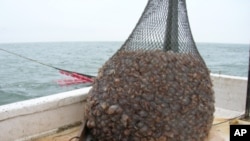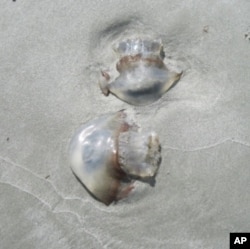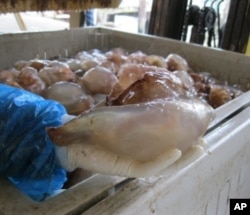Jellyfish are lovely creatures to behold underwater, as their gelatinous, tentacled bodies undulate in the currents. They are also a nuisance and a hazard. They can sting swimmers and clog fishing nets.
But, along the coast of the southern U.S. state of Georgia, jellyfish are a valuable export, which end up on dining tables across Asia.
Early on this chilly February morning, most everyone in the tiny coastal town of Darien is still asleep, but on the docks of Marco Seafood, along the Darien River, there’s plenty of activity. The shrimp trawler, Kim C. King, has just moored, and nearly 100 workers are ready to start processing last night’s catch of jellyfish, which the locals call jellyballs.
“Basically jellyballs have been a nuisance to fisherman for 100 years,” says Thornell King.
TK, as everyone calls him, owns three shrimp boats, but each winter, when shrimp season is over, he sets his nets for jellyballs. That’s just his part time job.
“Actually other than catching jellyballs, I’d much rather catch criminals," he says. "I’m a Georgia State Trooper.”
TK has been jellyballing for 14 years. Jellyballs - they’re actually cannonball jellyfish - are found in the warm coastal waters of the southeastern United States. They’re seasonal - starting to appear in late winter and continue to be seen through the beginning of shrimping season in June and JulyAccording to Georgia state marine biologist Jim Page, they’re very common. “We always kind of laugh but, when they’re abundant, you could just about walk on water with them, you could walk from one to the next.”
They look like big floating mushrooms.
“They have a pretty solid core, a fairly rigid core, on the underside of a dome shaped cap," Page says. "The cap is real soft. It is clear typically, usually has a maroon coloration around the outer edge of that cap, the soft dome that’s on top.”
Their tentacles are shorter than those of other jellyfish, and cannonballs don’t sting. Most are about the size of grapefruits, although some can be as big as basketballs.
During shrimping season, they often get trapped in nets, so shrimpers have installed special devices - called jellyball shooters - in their nets to clear them out.
Darien became a jellyfish hub two decades ago, when a man named George Tai started catching them and exporting them to Asia. When he left Darien, he sold the processing plant and his fishing equipment to TK and his partner. Today, Marco Seafood is the area’s only jellyfish processor and exporter, even though the creatures can be found all along the southeastern coast, from North Carolina to Florida.
The jellyfish are dried, preserved and packaged before being sold to a seafood distributor that ships them to Japan, China, and Thailand.
There, dried jellyfish are a delicacy, used in soups and salads.
TK says they’re crunchy. “Actually they taste a little like the gristle of a chicken bone. It’s got that crunchy taste and that’s what the people in Japan and China, they like that crunch.”
Marine biologist Page has tried them, too. He’s not a fan. “One time and that was gracious plenty for me. They were more salty than anything. It was not my favorite, but fortunately there’s others out there that found it to be a favorite.”
Jellyball fishing is Georgia’s third largest commercial fishery - after shrimp and crabs - but only five boats are permitted to catch them. That’s because Marco Seafood can handle only about 22,000 thousand kilos of jellyfish - one boat load - at a time, and there are no other processors.
So for now, although there’s an almost unlimited supply of jellyballs, and TK thinks demand for his dried jellyfish will only increase, Asian gourmands will have to be satisfied with a limited supply of Georgia jellyfish.










